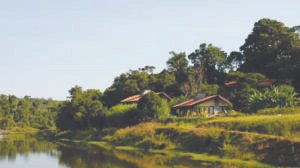
Dean D’Cruz elaborates on his projects, sustainability, challenges and future plans
Dean D’Cruz is the co-founder and principal architect of Mozaic – an architecture and design firm in Goa. He spent his early years schooling in Bombay and the US while enjoying technology and sciences. His father was an engineer and in typical style felt his son should follow his footsteps. “Fortunately, I did not get into IIT and chanced upon the J.J. campus while strolling back from the IIT entrance exam hall,” he says. The historic and beautiful campus of J.J. College of Architecture had an exhibition of architectural drawings on, which intrigued Dean and without knowing much about architecture, he applied for the course and got in. “The course was like no other with a mixture of the Sciences and the Arts in a campus that gave birth to some of the most famous artists we have today.”
Over the years, he has designed over 250 houses, 50 hotels, 30 housing complexes, institutions, offices and factories. According to Dean, every project is unique and has its own joy as well as challenges. “The one that brought us into the limelight was Nilaya, which was rated as one of 100 best small hotels of the world at one time and even recently elebrated by our Town Planning Minister on the floor of the Assembly!”
More recently, his firm has been involved in designing lodges mainly in tiger sanctuaries cross India where the thrust is to use local materials and craftsmanship to create buildings that blend with the environment, creating a oneness with nature and at the same time providing a great level of comfort for its guests.

“The many homes e have designed across India also try to respond to local materials and site conditions as well as the unique needs of the client going beyond their aspirations and needs into creating works of art that express their unique lifestyle,” Dean adds.
As an architect Dean avoids falling into a trap of a style and hence experiments with different design approaches in their buildings. “We see what is appropriate for the moment and push the clients’ sensibilities to look beyond their limited brief and collaborate with them in evolving a design that excites us both.”

Laurie Baker and Antoni Gaudí have been two major influences on Dean’s work because of their ability o create an architecture that is expressive, low cost and well crafted.
Dean is an advocate for sustainability and says that is should be a part of every architect’s vocabulary especially with the environmental crisis we are facing and which will only get worse. “It is important that we educate decision makers, like politicians, bureaucrats, developers and builders into the need to use materials and technology that minimise the impact on the environment. Far too often in our endeavour to build we do so in excess going far beyond the actual needs. We need architecture that can be multi-purposed, flexible and cost effective. When people speak about sustainability I believe it comes from the use of resources and cost is a good measure of the resources used. In India, now the world’s most populous country, we have had a great history of amazing buildings built by master craftsman and unfortunately we are fast losing building crafts. I believe to be sustainable we need uo move away a bit from the excessive industrialisation and standardisation and allow for craftsmanship that provides much needed livelihoods for our people. This will not only create an architecture that is richer than the horrid boxes that we see today, but also provide a greater level of personalisation and connection we have ith our buildings.

Dean has conducted numerous workshops on architecture, lanning and environment along with works published in leading newspapers and magazines, both in India and abroad. “I have been in academics for the last 30 years, Design Chair for a few nstitutions like Goa College of Architecture, SMEF’S Brick School, Pune, etc and on he Board of Studies for others like, School of Planning and Architecture Vijayawada, School of Planning and Architecture Bhopal, among others. I have also helped anchor study Programs for PRATT Institute, New York, Oxford Brookes University UK, and Royal Institute for Art, Sweden, for their planning exercises in Goa.
Goa offers a unique combination of rural and urban settlements as well as a richness of a diverse cultural heritage and an amazing natural heritage, being one of the top bio-diverse hotspots of the world.” Dean faces his share of roadblocks and challenges. Influencing clients to be sustainable and sensible in their choices he says is a big challenge and a bit of hand-holding needs to be done in this and the best way is to walk the talk. “Hence our offices are run fully on solar, we have created permaculture area with self sustaining food forest and our offices are not air conditioned and merge into the landscape. This helps a potential client in understanding our agenda.”
“Corruption is another challenge in the building industry. With real estate prices constantly shooting up, development in Goa has reached destructive levels with a compromise on sustainability and the environment. The Floor Area Ratio (FAR) available now and the loose town planning laws along with the heavy handedness on the part of the local bodies, are only changing the character of Goa for the worse.” Dean is part of the Goa Foundation and fighting as well as educating youth on the need to be sustainable and the small victories along the way, inspires him and gives him the strength to move ahead despite the many hurdles and threats thrown at them. “The youth through movements like ‘Amchem Mollem’ have proven that they are concerned about the environment and willing to devote their time and energies to keep Goa pristine and that gives me great hope.”
Having been in the practice for the last 40 years Dean says that he has a lot to share and plans to document his work. “I plan to document our works and philosophies as well as influence curriculum changes in the design field to make the role of being an architect more relevant for today’s society with its environmental and social challenges,” he concludes.





